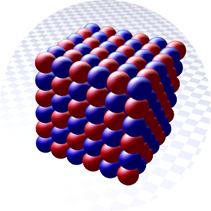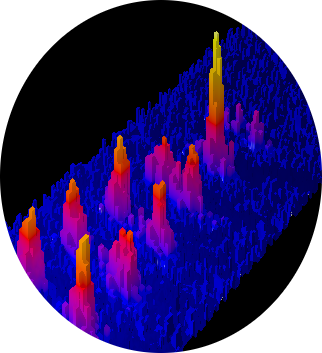Experiments with Ultracold Lithium Atoms
The Hulet group uses ultracold lithium atoms to explore quantum many-body phenomena. Using optical lattices, we confine atomic fermions to periodic potentials or to low-dimensions where strong correlations and emergent behavior arise. The extreme tunability of lattice parameters, density, and even geometry, fulfills the requirements of a versatile analog quantum simulator. The analog quantum computer can reveal some of the most exotic quantum behavior, that remains inaccessible to ordinary digital computers.
We confine fermions into one-dimensional (1D) “wires” and have measured, for the first time, the speed of sound in these wires as a function of the interactions in the wire. The ultimate goal is to demonstrate one of the most remarkable quantum many-body phenomenon, spin-charge separation. We are also attempting to create Majorana fermions in a 1D gas with p-wave interactions in a geometry that may be useful to realize the Kitaev model of topological quantum computing. And in another experiment, performed in the dimensional crossover between 1D and 3D, we are attempting to discover the “smoking gun” for the exotic FFLO state, where superfluid and magnetic order co-exist.
We also create Bose-Einstein condensates of lithium and use them to discover new quantum effects in the behavior of matter-wave solitons. These solitons, whose existence depends on 1D confinement, are solutions of exactly integrable equations, and are thus incredibly sensitive to subtle quantum effects. We have recently observed a new type of higher order soliton, called a "breather".
Spin-Polarized Fermions in 1D and 3D |
We explore how superfluid pairing responds to an effective magnetic field. We are attempting to find evidence for the elusive superfluid/superconducting state known as FFLO. |
|---|---|
Fermions in an Optical Lattice |
We have realized the 3D Hubbard model using spin-1/2 fermions in an optical lattice. We have observed antiferromagnetic correlations and are now exploring the doped Hubbard model where evidence for pseudo-gap physics may arise. The ultimate goal is to determine whether the Hubbard model contains the essence of d-wave superconductivity. |
Bosons Near a Feshbach Resonance |
In our bosonic lithium experiment we explore the broad Feshbach resonance to study the Efimov Effect and matter-wave solitons. |




